by Maria Porges
Here and Home, a compelling, tightly edited retrospective of the work of Bay Area photographer Larry Sultan, offers a chance to view the highlights of a 35-year career. Sultan, who died in 2009 of cancer, was a charismatic professor at California College of the Arts for two decades,
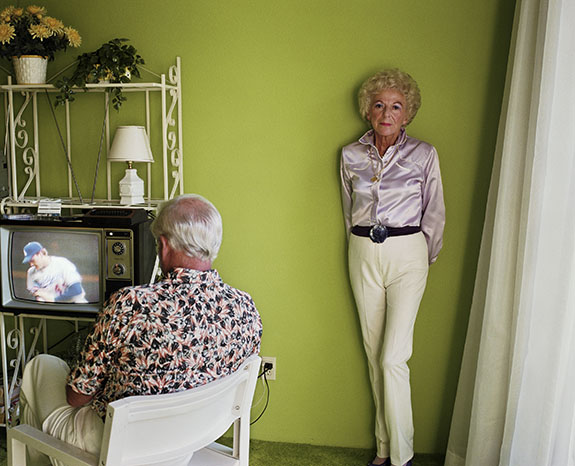
and taught before that for ten years at his alma mater, the San Francisco Art Institute. Widely loved and respected by his students and colleagues alike, he is known for work that explores the physical and psychological landscape of his childhood: the endless suburbia of southern California’s San Fernando Valley. In three bodies of work presented sequentially, Sultan’s gaze rests on the houses of his youth and on others he later observed as an adult in Northern California.
The theme first emerges in Pictures From Home. Consisting of staged and candid images the artist shot of his parents between 1982 and 1992, and family photos and film stills taken from home movies, this haunting group of made and found images reveals almost as much about Sultan as it does about his parents. The book form of this deeply personal exploration includes substantial passages of Sultan’s writing, which is regrettably absent from the exhibition. Still, the pictures tell the most important parts of the story: principally, about the artist’s atavistic 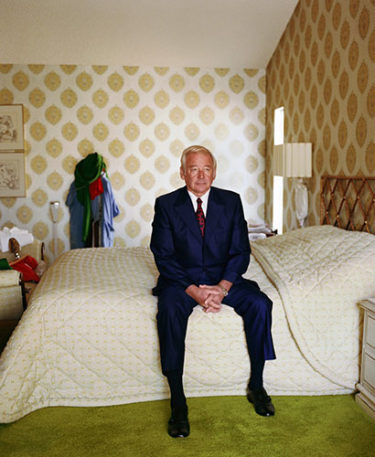
A massive grid of the home movie stills, inspired by watching the original films with his parents, dominates one gallery. Nearby, posed portraits of his parents seen alongside their peers at conventions — his father was a salesman for Schick—invoke a lost past, where men spent entire careers working for a single corporation. Other images of his father, standing by an empty pool or seated on his bed clad in a suit, suggest the melancholy of early retirement.
Deeper into the exhibition we realize that his parents have been replaced by others in a living room much like their own, except that in these the people are nearly naked, and some of them are, well, doing things. In 2004, Sultan took an assignment from the men’s magazine Maxim to photograph a day in the life of a porn star as it unfolded in one of the bland middle-class homes rented for that purpose. Discovering that the adult film industry had colonized the landscape of his childhood on the very same street where his first crush lived, he returned to take more pictures over a period of years. Eventually, these became the series called The Valley. In these peculiar, funny, and sometimes disturbing images, we see the ordinariness of what takes place:
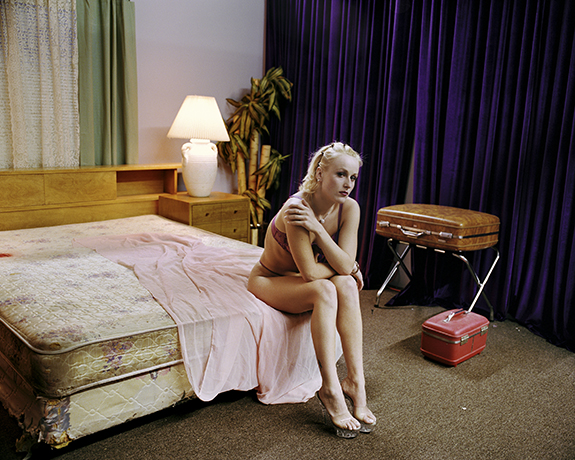
the bored moments between takes, where the actors sometimes smile for the camera but often not. Still, the houses are revealed to be the real protagonists, as Sultan draws our attention to details that might otherwise go unnoticed: a box of tissues, a stuffed animal belonging to the home’s actual inhabitants – not the people in front of (and behind) the camera. If Pictures from Home frames the longing for family and childhood, The Valley stands as a brutally ambivalent soliloquy about that dream – deflated by attractive naked bodies acting out flimsy plotlines that serve as pretexts for the same acts performed over and over.
Homeland, the last body of work in Sultan’s trilogy, was shot in various locations in Northern California. To make these pictures, Sultan hired Latino day laborers to enact dramas at the edges of housing developments: on weed-covered patches of broken ground or along streams 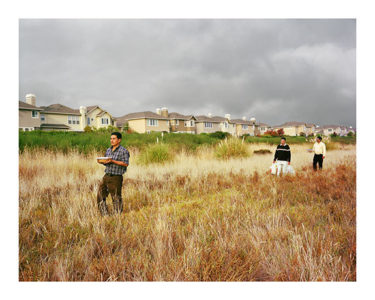
Evidence, a collaboration with Mike Mandel (who has a concurrent solo exhibition running at SFMOMA through August 20) gets ample wall space in the first room of the show. It’s something of an outlier in this exhibition, but it’s also one of the artists’ crowning achievements. First published as a book in 1977 and exhibited ever since as a classic of conceptual photography, the series was culled from the files of corporations, government agencies, and 
Sultan and Mandel also collaborated on many billboards; these were essentially corporate-sanctioned guerilla acts, made with the permission of outdoor advertising companies that had vacant space to donate. One example, Oranges on Fire (1975), can be seen on a wall near the museum café, and on the street near the Minnesota Street Project where a selection of Sultan’s substantial editorial work — commissioned by magazines – was concurrently on view at Casemore Kirkeby Gallery. These included several images of sleek, if sometimes silly, modern furniture, pictured at the headquarters of Vivid, an adult film company. There are also portraits of personalities (San Francisco socialite Denise Hale, with a snarling tiger skin rug at her feet), and Paris Hilton, reclining demurely in Sultan’s parents’ bedroom. Sometimes it’s possible to identify the product advertised even without looking at the title, as in Bottega Veneta #3 (2008), in which a model, imprisoned like a princess in a moated glass house, clutches a golden handbag. But no amount of contemplation will reveal the meaning of a picture like Belarus #1 (2006), with its thuggish ballerina showgirls, alert ring-tailed rodent and kindly old voyeur. Most mysterious of all, though, is Silver Curtain (1997), the only picture in both the gallery and the museum show. It simultaneously suggests revelation and concealment, but of what?
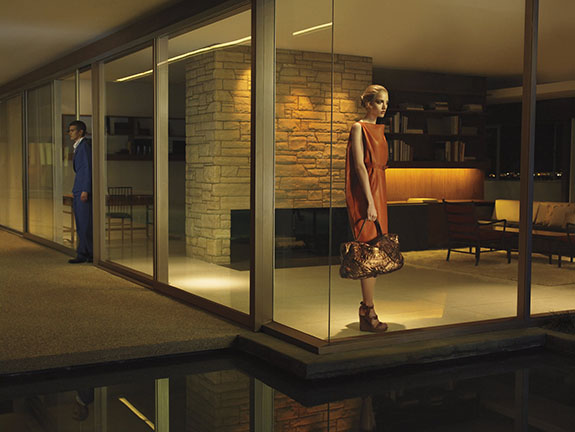
In a final room of the museum show, visitors can sit and swipe through touch screens loaded with images from the artist’s archives, intended to offer “a unique lens on his exploratory process.” While they accomplish that goal, they also suggest the extent to which Sultan’s career was cut short at age 63, long before he was out of ideas.
# # #
Larry Sultan: Here and Home @ SFMOMA through July 23, 2017. Larry Sultan: Editorial Works closed June 10, 2017 at Casemore Kirkeby Gallery.
About the Author:
Maria Porges is an artist and writer who lives and works in Oakland. For over two decades, her critical writing has appeared in many publications, including Artforum, Art in America, Sculpture, American Craft, Glass, the New York Times Book Review and many other publications. The author of nearly 100 exhibition catalog essays, she presently serves as an associate professor at California College of the Arts.